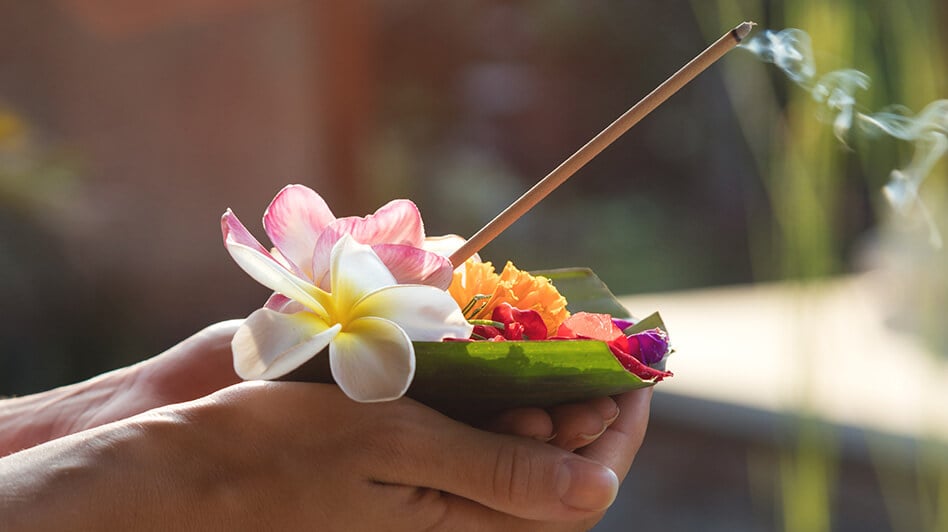
How To Activate Your Sacred Space & Energize Your Altar With Cosmic Vibrations

Creating your own sacred space to go deep inside is one of the greatest acts or rituals in life that you can do that will provide a treasure chest of peace, happiness, and balance.
A sacred space is a dedicated space in your home or environment that you can go to daily, that is devoted to your inner journey. It may be an area in your home or in nature where you reflect, meditate, pray, chant, sing, write, or do spiritual practices that bring you in contact with your True Nature.
Your sacred space is an intimate place where you feel safe to go inside uninterrupted, and becomes a powerhouse of pure positive energy that is collected and contained throughout your daily practices.
It may involve setting up a formal physical altar, doing daily rituals, or simply sitting and reflecting in solitude. Whatever you choose to become your sacred space activates a grounding station in your life, for which you can continually come back into peace and harmony.
7 STEPS TO CREATING A SACRED SPACE
1. SOLITUDE & PEACE
Perhaps the most important factor to consider when creating your sacred space is that is allows for the greatest peace, silence, and uninterrupted solitude.
Creating your sacred space in Mother Nature is a wonderful possibility, and in doing so, also allows you to benefit from the positive electromagnetic forces of Mother Earth by doing your spiritual practices in her lap. However, it is often hard to control for outside factors when in nature, for example privacy or weather conditions, that allow for Mother Earth to be your sole constant uninterrupted sacred space.
Many people choose to find a place in their home to create their sacred space, that is quiet, private and dedicated solely for the purpose of their own inner journey. This place may contain an altar or spiritual items that remind you of your innate Divinity as well as provide you with positive spiritual vibrations for maintaining your practices.
2. INSPIRING & FILLED WITH LOVE
Your sacred space should include items or objects that remind you of your pure Divinity; your True Self.
This may include power objects, such as the Sri Chakra or Siva Lingam, or statues (murtis) that represent Divinity- such as Saraswati Devi, Nataraja Shiva, Narayana, Krishna, Jesus, Mother Mary, The Buddha, Mahavira- or empty space to represent the formless Absolute Consciousness.
Your altar may include yantras or mandalas (mystical diagrams), sacred rocks, crystals, stones or blessed items, or any object that has spiritual significance to you and that reminds you of love and truth. You may like to include on our altar pictures of your teachers (gurus) or anyone that is inspirational on your pathway home.
3. DISCIPLINE & DEVOTION
Your sacred space should inspire you to make it your true home – a place you go to be in silence, to meditate, to reflect, to pray, to cry, to let go, to love, and to release the burden or the stresses of life.
You can create your sacred space in such a way that it’s comfortable and inviting- adding any sitting cushions, props, or personal touches to make it feel like home. In this way, you are called to spend time in your sacred space daily, to remain at peace, keep in balance, go deeper within, spark the light of creativity and to let go of any difficulties.
We all wish for peace and happiness in our lives, and it is due to our dedication and devotion to our inner journey that allows for this transformation to take place- and our sacred space provides for a supportive and nurturing environment for our spiritual practices to be cultivated.
4. SUBTLE ENERGY PRINCIPLES
According to the tradition of Vaastu, or the science of sacred space, we would place our sacred space in the Northeast direction, or if this isn’t possible than in the East or the North direction. These directional energies promote spiritual progress and positivity or auspiciousness and support our spiritual journey. When we set up our altar in these directions our statue (murti) or spiritual objects would be facing us, as we face in the direction of Northeast, East or North.
In many traditions, the statue (murti) or power objects, and sacred books, are place on a cloth or table and do not make direct contact with the floor. This is to preserve the energy within the power object, so that the earth’s magnetic field is less likely to pull down the energy with her gravitational force. Also, the power object or murti is often positioned at the highest place on the altar to symbolize the highest level of Consciousness. In some customs, it is considered disrespectful to place an image of a deity at a lower position on the ground.
5. COLLECTING AND CONTAINING ENERGY
To preserve the energy of your altar and power objects it is encouraged to keep them in one place- only moving them to clean the altar or power object or to perform rituals which charge their energy.
Some people love to take their altar with them while traveling, and sacrifice the energy lost by moving the altar, with the energy that is gained while they continue their spiritual practices in the presence of their altar. While others have an altar that they keep largely untouched in their home, and take a smaller version of their altar with them while traveling.
Your sacred space, altar and power objects all collect and contain the energy that you harness during your spiritual practices, and reflect this energy to you during your sadhana (spiritual practices). As such, you greatly benefit from doing your spiritual practices, whenever possible, in your sacred space as that space gets charged with positive spiritual vibrations that continue to bathe you in positivity.
Also, to preserve the energy of your sacred space and items, you might like to reserve a special cloth that is used solely for the purpose of cleaning your altar, or conversely, you can use a new, unused tissue to clean your altar and dispose of the tissue with each use. This keeps the energy of the altar and power objects pure and concentrated- allowing the energy to continue to build within the space.
When engaged in your spiritual practices (sadhana) it is a wise idea to keep the same sitting cushion, yoga mat, and to use a darbha (special grass) mat whenever possible. When we use the same items again and again in our sadhana, it enables the energy to build within us. It is also common practice for people to use the same clothes solely for spiritual practices and to use white colored clothing. The color white contains all the colors of the rainbow, and thus contains all the properties that are present in the spectrum of light and allows you to charge your seven subtle energy centers, known as the chakras. The color white also represents purity and helps your vibratory field to come into it’s pure Natural State.
6. THE 5 ELEMENTS
The 5 elements: earth, water, fire, air and space are what constitutes all of creation and when kept in balance creates balance within and without. Your sacred space can also contain a representation of these 5 elements to help balance and restore these 5 elements within yourself and within your immediate environment.
Earth: Flowers, rocks, crystals, stones, shells or a plant placed near your space or altar can represent the element of earth. Likewise, during the ritual performance of pujas or sacred ceremonies, food is often placed near the altar to be charged with mantra japa (the repetition of mantra or sacred sound syllables) and the spiritual energy that is derived from the ceremony- these charged food items are then later passed on to others as blessed food items or prasadam so that they may ingest the positive vibrations from the spiritual ceremony.
Water: You can have a small bottle of holy water or blessed water on your altar space or have a water feature (for example a pond, waterfall, pool) nearby to represent the element of water. In addition, you can take a shower or bath before your spiritual practices to invite in the water element as well as purify the body and mind to prepare to receive the greatest benefits from your sadhana or spiritual practices.
Fire: The fire element is the most common and perhaps most significant element to invoke. Fire represent light, and this light is ultimately the Light of Knowledge. By lighting a candle (if possible a ghee lamp due to its beneficial properties), we are invoking the inner light of Self- Knowledge to shine forth; we are invoking the inner guide to light our pathway home. Fire also represents the purification of all impurities so that the truth can be known.
Air: The air element is commonly represented by the lighting of incense. The smell of incense is said to invoke light beings (devas) to be present during your spiritual practices to help guide you on your path. The lighting of incense is also a representation of the purification of that which is untruth (avidya) to that which is truth (vidya) and its smell symbolizes the divine virtues.
Space: Flowers can once again represent the space element due to its fragrance or scent which is invisible. The essence of the flower scent represents that which can’t be seen; space, and its fragrance represents divine beauty or virtues. Camphor is used in ritual practices such as pujas to represent ether as it burns completely and purely, leaving nothing but space or akasha in its wake. The burning of essential oils or herbs may also represent the space element, as once again they represent that which can’t be seen, as well as their fragrance symbolizes divine attributes.
Whether your sacred space contains 1, 2, 3 or all 5 elements, or no elements at all, depends upon what is meaningful and significant to you.
7. INTENTION
All the physical items that constitute your sacred space or altar are simply there to reflect your True Self. Your sacred space, most importantly, is there to bring you into a place of inner stillness and silence so that you can truly BE AS YOU ARE. In so much as you love and trust, so shall love and trust be by your side. If your sacred space is cherished, so shall it cherish you.
If you wish to rest in your pristine, pure Natural State without the need for an altar or sacred objects to remind you of your True Nature, then let it be so. Truly and fundamentally, sacred space is all that is, within and without.




























